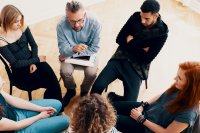Teaching Survivors of the Opioid Epidemic
Students’ personal experiences with the opioid crisis serve as powerful catalysts for a change-driven curriculum.
Your content has been saved!
Go to My Saved Content.On a recent spring morning, my senior English students were talking with a guest speaker, an emergency medical technician from our community, about the opioid epidemic. One student asked, “How has dealing with all these overdoses changed your feelings about your job, and how has it changed your home life?”
The surprise on our guest’s face was apparent. “Nobody has asked me that before,” he said. The atmosphere in the room changed, as did the way our guest spoke to the kids: It became more personal. He told them that he had walked away from his job once after responding to an overdose call that reminded him too much of his children, only to return later.
Students who typically sneak glances at their phones were riveted, actively listening, nodding in understanding and empathy.
Our small rural school in Eastern Kentucky sits at the center of the opioid epidemic. Forty people died from opioid overdose in our county in 2018. Although it is the new normal for our community, we don’t often discuss it in the classroom.
Start With Student Experience
I started the unit by asking the students to write impact statements. Of the approximately 80 students, 58 wrote about a family member (immediate or extended) or a close friend who was in recovery, was actively using drugs, or had died from overdose.
The students shared their experiences:
“If my dad was alive today, I try and think he would be better, but honestly, the drugs are so bad still that maybe it’s good he’s already dead.”
“My other buddy had Narcan [naloxone] and was able to bring him back, but barely. EMT came. He’s still using.”
“I was only 8, and when we walked into the drug dealer’s house, [name redacted] was laying on a couch with a needle in her arm.”
The student experience centered the development of the rest of our engagement around what mattered most to the students.
Enlist Help in Shaping Curriculum
I used their statements as a springboard for a conversation about a curriculum we might develop using the book Dreamland, by Sam Quinones, which traces the opioid crisis through the lens of an Ohio community devastated by the epidemic. What had started as a book study quickly took on a larger scope.
My students had questions about the epidemic. Some wanted to understand the nature of addiction. Others were looking for ways to help family members in their recovery. Still others wanted to know if someone was going to be held responsible for the influx of drugs into our communities. Many worried about their own risk of repeating a cycle of addiction and wanted to know how to avoid it.
Their questions not only guided their research but determined how we spent class time. In-class surveys produced a suggestion to create pamphlets for schoolwide distribution that outlined available support services. The students also created short oral presentations about self-care for those living in highly stressful environments.
Students wanted to hear from primary sources, so we invited first responders, the coroner, mental health professionals, and recovering addicts to speak. Sam Quinones teleconferenced with the students about his research methods and what had drawn him to our part of the country in his investigations.
Students have taken ownership of this line of study in a way that I have seldom seen. They have skin in the game, so they are engaged and invested in the information they seek.
For example, one student hypothesized that recovery is more likely when the family unit is maintained, rather than removing children from the home. Though she found evidence that contradicts her working thesis, she is investigating her sources and reviewing their credibility. She is informing herself as a consumer of information, but she is also finding peace in her foster care situation while educating herself about her mother’s recovery program.
The quality of discussion in class has grown and expanded. Students who have never spoken up in class have ideas to add. Those who experienced shame because of the addiction in their families have shared the coping mechanisms they have discovered. They are reaching out to one another and holding one another accountable for such unexpected things as attendance, academic performance, and self-care. They are asking for services, especially from our counselors, and are speaking up for themselves and their classmates.
Move to Solutions
Something magical is happening beyond this work: They are contemplating solutions.
After the EMT guest speaker, the students wondered if he would be available to help with a community cleanup since he already knew the safe way to deal with hypodermics. He agreed, and the students have planned a cleanup in May. The conversation turned to the cost of naloxone, compassionate response, and ways that other communities have been addressing the numbers of people with addictions.
A few of the kids wanted to put together comfort food and adult coloring books for the firehouse where the EMT was stationed. “He helped revive my brother-in-law. I’d like to do something for him,” one student said.
The students wrote to legislators to advocate for support of measures to address the issue, and they registered to vote so they could help elect individuals who might be able to pass effective legislation.
These ideas are nascent and evolving, but these young people are internalizing the idea that even though what they see is common in our area, they do not have to accept it as the new normal. Education is empowering them to break a cycle, move beyond what others may assume about them, and take charge of their futures.
